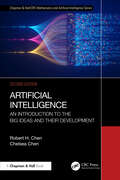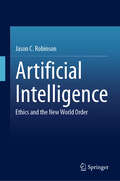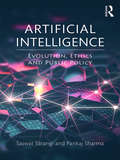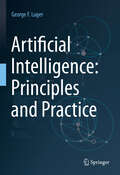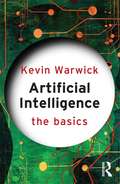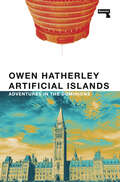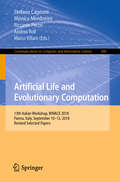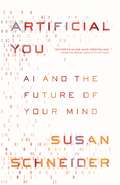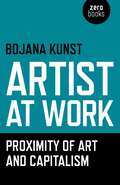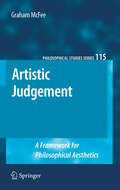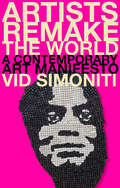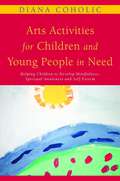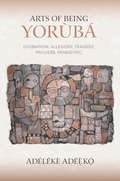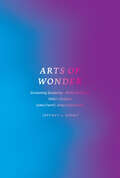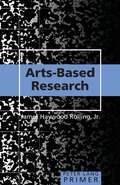- Table View
- List View
Artificial Intelligence: An Introduction to the Big Ideas and their Development (Chapman & Hall/CRC Mathematics and Artificial Intelligence Series)
by Robert H. Chen Chelsea ChenArtificial Intelligence: An Introduction to Big Ideas and their Development, Second Edition guides readers through the history and development of artificial intelligence (AI), from its early mathematical beginnings through to the exciting possibilities of its potential future applications. To make this journey as accessible as possible, the authors build their narrative around accounts of some of the more popular and well-known demonstrations of artificial intelligence, including Deep Blue, AlphaGo and even Texas Hold’em, followed by their historical background, so that AI can be seen as a natural development of the mathematics and computer science of AI. As the book proceeds, more technical descriptions are presented at a pace that should be suitable for all levels of readers, gradually building a broad and reasonably deep understanding and appreciation for the basic mathematics, physics, and computer science that is rapidly developing artificial intelligence as it is today. Features Only mathematical prerequisite is an elementary knowledge of calculus. Accessible to anyone with an interest in AI and its mathematics and computer science. Suitable as a supplementary reading for a course in AI or the History of Mathematics and Computer Science in regard to artificial intelligence. New to the Second Edition Fully revised and corrected throughout to bring the material up-to-date. Greater technical detail and exploration of basic mathematical concepts, while retaining the simplicity of explanation of the first edition. Entirely new chapters on large language models (LLMs), ChatGPT, and quantum computing.
Artificial Intelligence: Ethics and the New World Order
by Jason C. RobinsonThis thought-provoking book explores the most promising and threatening technology imaginable—artificial intelligence (AI) or thinking-machines. Following the shocking release of generative AI (ChatGPT) in 2022, questions about the future of humanity and our role as apex minds have exploded with great urgency. The book contributes uniquely to AI conversations in three main ways. First, it broaches questions often ignored by AI developers and tech-enthusiasts, including corporate responsibility and the role technology plays in the widespread manipulation of cultures for profit and power. Second, it asks big and unanswered questions about the nature of thinking, consciousness, morality, purpose, and the good life, as a means of laying the foundation needed to create a better AI. Third, by framing AI evolution in three unique stages of development—Oz, Feallan, and Adouren—it takes readers far beyond the present horizon of large language models. While being accessible to a wide audience, this book offers a thought-provoking examination of the most pressing questions and risks of AI.
Artificial Intelligence: Evolution, Ethics and Public Policy
by Pankaj Sharma Saswat SarangiWhat will the future be? A dystopian landscape controlled by machines or a brave new world full of possibilities? Perhaps the answer lies with Artificial Intelligence (AI)—a phenomenon much beyond technology that has, continues to, and will shape lives in ways we do not understand yet. This book traces the evolution of AI in contemporary history. It analyses how AI is primarily being driven by "capital" as the only "factor of production" and its consequences for the global political economy. It further explores the dystopian prospect of mass unemployment by AI and takes up the ethical aspects of AI and its possible use in undermining natural and fundamental rights. A tract for the times, this volume will be a major intervention in an area that is heavily debated but rarely understood. It will be essential reading for researchers and students of digital humanities, politics, economics, science and technology studies, physics, and computer science. It will also be key reading for policy makers, cyber experts and bureaucrats.
Artificial Intelligence: Principles and Practice
by George F. LugerThis book provides a complete introduction to Artificial Intelligence, covering foundational computational technologies, mathematical principles, philosophical considerations, and engineering disciplines essential for understanding AI. Artificial Intelligence: Principles and Practice emphasizes the interdisciplinary nature of AI, integrating insights from psychology, mathematics, neuroscience, and more. The book addresses limitations, ethical issues, and the future promise of AI, emphasizing the importance of ethical considerations in integrating AI into modern society. With a modular design, it offers flexibility for instructors and students to focus on specific components of AI, while also providing a holistic view of the field. Taking a comprehensive but concise perspective on the major elements of the field; from historical background to design practices, ethical issues and more, Artificial Intelligence: Principles and Practice provides the foundations needed for undergraduate or graduate-level courses. The important design paradigms and approaches to AI are explained in a clear, easy-to-understand manner so that readers will be able to master the algorithms, processes, and methods described. The principal intellectual and ethical foundations for creating artificially intelligent artifacts are presented in Parts I and VIII. Part I offers the philosophical, mathematical, and engineering basis for our current AI practice. Part VIII presents ethical concerns for the development and use of AI. Part VIII also discusses fundamental limiting factors in the development of AI technology as well as hints at AI's promising future. We recommended that PART I be used to introduce the AI discipline and that Part VIII be discussed after the AI practice materials. Parts II through VII present the three main paradigms of current AI practice: the symbol-based, the neural network or connectionist, and the probabilistic. Generous use of examples throughout helps illustrate the concepts, and separate end-of-chapter exercises are included. Teaching resources include a solutions manual for the exercises, PowerPoint presentation, and implementations for the algorithms in the book.
Artificial Intelligence: The Basics (The Basics)
by Kevin Warwick'if AI is outside your field, or you know something of the subject and would like to know more then Artificial Intelligence: The Basics is a brilliant primer.' - Nick Smith, Engineering and Technology Magazine November 2011 Artificial Intelligence: The Basics is a concise and cutting-edge introduction to the fast moving world of AI. The author Kevin Warwick, a pioneer in the field, examines issues of what it means to be man or machine and looks at advances in robotics which have blurred the boundaries. Topics covered include: how intelligence can be defined whether machines can 'think' sensory input in machine systems the nature of consciousness the controversial culturing of human neurons. Exploring issues at the heart of the subject, this book is suitable for anyone interested in AI, and provides an illuminating and accessible introduction to this fascinating subject.
Artificial Islands: Adventures in the Dominions
by Owen HatherleyShould Britain form a new union with its old 'Dominions' in Canada, Australia and New Zealand? Are they really our closest allies and relations? And is there any reason why they should want to unite again with us?Great Britain has just left one Union, after years of bitter argument and divisive posturing. But what if the island's future lies in another Union altogether, with some of its former colonial &“kith and kin&” across the seas? Why be in a Union with your immediate neighbours, when you could instead be in a trans-oceanic super-state with our old friends in Canada, Australia and New Zealand? Welcome to the strange world of the 'CANZUK Union', the name for a quixotic but apparently serious plan to reunify the white-majority 'Dominions' of the British Empire under the flag of low taxes, strong borders and climate change denialism.Artificial Islands tests the idea that Britain's natural allies and closest relations are in these three countries in North America and the Antipodes, through a good look at the histories, townscapes and spaces of several cities across the settler zones of the British Empire. These are some of the most purely artificial and modern landscapes in the world, British-designed cities that were built with extreme rapidity in forcibly seized territories on the other side of the world from Britain. Were these places really no more than just a reproduction of British Values planted in unlikely corners of the globe? How are people in Auckland, Melbourne, Montreal, Ottawa and Wellington re-imagining their own history, or their countries' role in the British Empire and their complicity in its crimes? And do they have any interest in a union with us?
Artificial Knowing: Gender and the Thinking Machine
by Alison AdamArtificial Knowing challenges the masculine slant in the Artificial Intelligence (AI) view of the world. Alison Adam admirably fills the large gap in science and technology studies by showing us that gender bias is inscribed in AI-based computer systems. Her treatment of feminist epistemology, focusing on the ideas of the knowing subject, the nature of knowledge, rationality and language, are bound to make a significant and powerful contribution to AI studies. Drawing from theories by Donna Haraway and Sherry Turkle, and using tools of feminist epistemology, Adam provides a sustained critique of AI which interestingly re-enforces many of the traditional criticisms of the AI project. Artificial Knowing is an esential read for those interested in gender studies, science and technology studies, and philosophical debates in AI.
Artificial Life and Evolutionary Computation: 13th Italian Workshop, WIVACE 2018, Parma, Italy, September 10–12, 2018, Revised Selected Papers (Communications in Computer and Information Science #900)
by Stefano Cagnoni Marco Villani Andrea Roli Monica Mordonini Riccardo PecoriThis book constitutes the revised selected papers of the 13th Italian Workshop on Artificial Life and Evolutionary Computation, WIVACE 2018, held in Parma, Italy, in September 2018. The 12 full papers presented were thoroughly reviewed and selected from 30 submissions. They cover the following topics: Boolean networks and complex systems; economic, societal and technological applications; chemical, biological and medical applications. The chapter “Unveiling Latent Relations in the Photonics Techno-Economic Complex System” is open access under a CC BY 4.0 license at link.springer.com.
Artificial Misinformation: Exploring Human-Algorithm Interaction Online
by Donghee ShinThis book serves as a guide to understanding the dynamics of AI in human contexts with a specific focus on the generation, sharing, and consumption of misinformation online. How do humans and AI interact? How is AI shaping our understanding of ourselves and our societies? What are the interaction mechanisms that govern how humans and algorithms contribute to misinformation online? And how do we bridge the gap between ethical considerations and practical realities to make responsible, reliable systems? Exploring these questions, the book empowers humans to make AI design choices that allow them meaningful control over AI and the online sphere. Calling for an interdisciplinary approach toward human-misinformation algorithmic interaction that focuses on building methods and tools that robustly deal with complex psychological/social phenomena, the book offers a compelling insight into the future of AI-based society.
Artificial Morality: Virtuous Robots for Virtual Games
by Peter DanielsonThis book explores the role of artificial intelligence in the development of a claim that morality is person-made and rational. Professor Danielson builds moral robots that do better than amoral competitors in a tournament of games like the Prisoners Dilemma and Chicken. The book thus engages in current controversies over the adequacy of the received theory of rational choice. It sides with Gauthier and McClennan, who extend the devices of rational choice to include moral constraint. Artificial Morality goes further, by promoting communication, testing and copying of principles and by stressing empirical tests.
Artificial You: AI and the Future of Your Mind
by Susan SchneiderA sober-minded philosophical exploration of what AI can and cannot achieveHumans may not be Earth’s most intelligent beings for much longer: the world champions of chess, Go, and Jeopardy! are now all AIs. Given the rapid pace of progress in AI, many predict that it could advance to human-level intelligence within the next several decades. From there, it could quickly outpace human intelligence. What do these developments mean for the future of the mind?In Artificial You, Susan Schneider says that it is inevitable that AI will take intelligence in new directions, but urges that it is up to us to carve out a sensible path forward. As AI technology turns inward, reshaping the brain, as well as outward, potentially creating machine minds, it is crucial to beware. Homo sapiens, as mind designers, will be playing with "tools" they do not understand how to use: the self, the mind, and consciousness. Schneider argues that an insufficient grasp of the nature of these entities could undermine the use of AI and brain enhancement technology, bringing about the demise or suffering of conscious beings. To flourish, we must grasp the philosophical issues lying beneath the algorithms.At the heart of her exploration is a sober-minded discussion of what AI can truly achieve: Can robots really be conscious? Can we merge with AI, as tech leaders like Elon Musk and Ray Kurzweil suggest? Is the mind just a program? Examining these thorny issues, Schneider proposes ways we can test for machine consciousness, questions whether consciousness is an unavoidable byproduct of sophisticated intelligence, and considers the overall dangers of creating machine minds.
Artist at Work, Proximity of Art and Capitalism
by Bojana KunstThe main affirmation of artistic practice must today happen through thinking about the conditions and the status of the artist's work. Only then can it be revealed that what is a part of the speculations of capital is not art itself, but mostly artistic life. Artist at Work examines the recent changes in the labour of an artist and addresses them from the perspective of performance.
Artistic Creativity: A Scientific Journey Through Homospatial, Janusian, and Sep-Con Articulation Processes (Palgrave Studies in Creativity and Culture)
by Albert RothenbergThis book presents the creative processes in art throughout history and cultures. A specific cognitive function, the homospatial process, is extensively documented and described, as well as short and long term scientific research in artistic creation and its applications to aesthetic appreciation. Drawing on research in psychology of creativity, creative operations, and relationship of mental health and illness to creativity, the author delves into the psychology of creativity in art and other fields, and presents intensive and experimental studies of Rembrandt’s self-portraiture, controlled experimental assessment of prizewinning young artists, descriptions of three key creative processes, and in-depth exploration of the operation of the specific creative homospatial process in works of art throughout history. The book also presents specific controlled experimentation on use of the homospatial process, its application in the creation of clothing design, and two explorations of major artists and the relationship of mental health and creativity, ending with a reflection on the role and function of creativity in society.
Artistic Judgement: A Framework for Philosophical Aesthetics (Philosophical Studies Series #115)
by Graham McfeeArtistic Judgement sketches a framework for an account of art suitable to philosophical aesthetics. It stresses differences between artworks and other things; and locates the understanding of artworks both in a narrative of the history of art and in the institutional practices of the art world. Hence its distinctiveness lies in its strong account of the difference between, on the one hand, the judgement and appreciation of art and, on the other, the judgement and appreciation of all the other things in which we take an aesthetic interest. For only by acknowledging this contrast can one do justice to the importance regularly ascribed to art. The contrast is explained by appealing to an occasion-sensitive account of understanding, drawn from Charles Travis directly, but with Gordon Baker (and Wittgenstein) as also proximate rather than remote. On this basis, it argues, first, that we need to offer accounts of key topics only as far as questions might be raised in respect of them (hence, not exceptionlessly); and, second, that we should therefore defend the view that the meaning of artworks can be changed by later events (the historical character of art, or forward retroactivism) and that art has an institutional character, understood broadly on the lines of Terry Diffey's Republic of Art. Besides providing a general framework, Artistic Judgement also explores the applications of the ideas to specific artworks or classes of them.
Artists Remake the World: A Contemporary Art Manifesto
by Vid SimonitiAn original and provocative exploration of the relationship between contemporary art, politics, and activism Artists Remake the World introduces readers to the political ambitions of contemporary art in the early twenty-first century and puts forward a new, wide-ranging account of art&’s political potential. Surveying such innovations as evidence-driven art, socially engaged art, and ecological art, the book explores how artists have attempted to offer bold solutions to the world&’s problems. Vid Simoniti offers original perspectives on contemporary art and its capacity as a force for political and social change. At its best, he argues, contemporary art allows us to imagine utopias and presents us with hard truths, which mainstream political discourse cannot yet articulate. Covering subjects such as climate change, social justice, and global inequality, Simoniti introduces the reader to a host of visionary contemporary artists from across the globe, including Ai Weiwei, Olafur Eliasson, Wangechi Mutu, Naomi Rincón Gallardo, and Hito Steyerl. Offering a philosophy of contemporary art as an experimental branch of politics, the book equips the reader with a new critical apparatus for thinking about political art today.
Artists in Uniform: A Study of Literature and Bureaucratism (Routledge Revivals)
by Max EastmanFirst published in 1934, Artists in Uniform confronts what the author describes as ‘two of the worst features of the Soviet experiment’ following Lenin’s death – bigotry and bureaucratism – and shows how they have functioned in the sphere of arts and letters. It is divided into three parts: The Artist’s International; A Literary Inquisition; and Art and the Marxian Philosophy.
Arto Salomaa: A Thematic Biography
by Jukka PaakkiThis book outlines the scientific career of Arto Salomaa, a pioneer in theoretical computer science and mathematics. The author first interviewed the subject and his family and collaborators, and he then researched this fascinating biography of an intellectual who was key in the development of these fields.Early chapters progress chronologically from Academician Salomaa's origins, childhood, and education to his professional successes in science, teaching, and publishing. His most impactful direct research efforts have been in the areas of automata and formal languages. Beyond that he has influenced many more scientists and professionals through collaborations, teaching, and books on topics such as biocomputing and cryptography. The author offers insights into Finnish history, culture, and academia, while historians of computer science will appreciate the vignettes describing some of the people who have shaped the field from the 1950s to today. The author and his subject return throughout to underlying themes such as the importance of family and the value of longstanding collegial relationships, while the work and achievements are leavened with humor and references to interests such as music, sport, and the sauna.
Arts Activities for Children and Young People in Need
by Diana CoholicArt-based activities can develop resilience and self-esteem, enabling children in need to cope better with ongoing stress and loss. Arts Activities for Children and Young People in Need offers interventions and exercises drawn from practice and research, for practitioners to use as a basis for their own arts-based groups or one-to-one sessions. Holistic arts activities facilitate a spiritually sensitive approach. Mindfulness-based exercises underpin the approach, and include guided meditations in which a group imagines that they are clouds, or draw feelings and emotions while listening to music, to encourage awareness of the senses. The activities help the group to relax and become more self-aware, encourage an exploration of feelings, values and understanding and are beneficial for children not ready to embrace traditional therapies or counselling. This book is accessible and suitable for helping, health and education practitioners and students from a variety of disciplines, such as social work, psychology and counselling.
Arts Education and Curriculum Studies: The Contributions of Rita L. Irwin (Studies in Curriculum Theory Series)
by Mindy R. Carter Valerie TriggsHighlighting Rita L. Irwin’s significant work in the fields of curriculum studies and arts education, this collection honors her well-known contribution of a/r/tography to curriculum studies in the form of arts based educational research and, beyond this, her contributions towards understanding the inseparability of making, knowing, and being. Together the chapters document an important beginning, as well as an ongoing transitional time in which curriculum understood as aesthetic text is awakening to the ways in which art practices stimulate a social awareness at the level of other embodied practices. Organized in three themes, gathering, transforming, and becoming, this volume brings together a selection of Irwin’s single and co-authored essays to offer a variety of rich perspectives to scholars and students in the field of education who are interested in the ways in which arts-based research allows the possibilities of bringing together the artistic, pedagogical, and scholarly selves of an educator.
Arts of Address: Being Alive to Language and the World (Columbia Themes in Philosophy, Social Criticism, and the Arts)
by Monique RoelofsModes of address are forms of signification that we direct at living beings, things, and places, and they at us and at each other. Seeing is a form of address. So are speaking, singing, and painting. Initiating or responding to such calls, we participate in encounters with the world. Widely used yet less often examined in its own right, the notion of address cries out for analysis.Monique Roelofs offers a pathbreaking systematic model of the field of address and puts it to work in the arts, critical theory, and social life. She shows how address props up finely hewn modalities of relationality, agency, and normativity. Address exceeds a one-on-one pairing of cultural productions with their audiences. As ardently energizing tiny slippages and snippets as fueling larger impulses in the society, it activates and reaestheticizes registers of race, gender, class, coloniality, and cosmopolitanism. In readings of writers and artists ranging from Julio Cortázar to Jamaica Kincaid and from Martha Rosler to Pope.L, Roelofs demonstrates the centrality of address to freedom and a critical political aesthetics. Under the banner of a unified concept of address, Hume, Kant, and Foucault strike up conversations with Benjamin, Barthes, Althusser, Fanon, Anzaldúa, and Butler. Drawing on a wide array of artistic and theoretical sources and challenging disciplinary boundaries, the book illuminates address’s significance to cultural existence and to our reflexive aesthetic engagement in it. Keeping the reader on the lookout for flash fiction that pops up out of nowhere and for insurgent whisperings that take to the air, Arts of Address explores the aliveness of being alive.
Arts of Being Yoruba: Divination, Allegory, Tragedy, Proverb, Panegyric
by Adélékè AdéèkóThere is a culturally significant way of being Yorùbá that is expressed through dress, greetings, and celebrations—no matter where in the world they take place. Adélékè Adék documents Yorùbá patterns of behavior and articulates a philosophy of how to be Yorùbá in this innovative study. As he focuses on historical writings, Ifá divination practices, the use of proverbs in contemporary speech, photography, gendered ideas of dressing well, and the formalities of ceremony and speech at celebratory occasions, Adéékó contends that being Yorùbá is indeed an art and Yorùbá-ness is a dynamic phenomenon that responds to cultural shifts as Yorùbá people inhabit an increasingly globalized world.
Arts of Living on a Damaged Planet: Ghosts and Monsters of the Anthropocene
by Anna Lowenhaupt Tsing Nils Bubandt Elaine Gan Heather Anne SwansonLiving on a damaged planet challenges who we are and where we live. This timely anthology calls on twenty eminent humanists and scientists to revitalize curiosity, observation, and transdisciplinary conversation about life on earth.As human-induced environmental change threatens multispecies livability, Arts of Living on a Damaged Planet puts forward a bold proposal: entangled histories, situated narratives, and thick descriptions offer urgent &“arts of living.&” Included are essays by scholars in anthropology, ecology, science studies, art, literature, and bioinformatics who posit critical and creative tools for collaborative survival in a more-than-human Anthropocene. The essays are organized around two key figures that also serve as the publication&’s two openings: Ghosts, or landscapes haunted by the violences of modernity; and Monsters, or interspecies and intraspecies sociality. Ghosts and Monsters are tentacular, windy, and arboreal arts that invite readers to encounter ants, lichen, rocks, electrons, flying foxes, salmon, chestnut trees, mud volcanoes, border zones, graves, radioactive waste—in short, the wonders and terrors of an unintended epoch.Contributors: Karen Barad, U of California, Santa Cruz; Kate Brown, U of Maryland, Baltimore; Carla Freccero, U of California, Santa Cruz; Peter Funch, Aarhus U; Scott F. Gilbert, Swarthmore College; Deborah M. Gordon, Stanford U; Donna J. Haraway, U of California, Santa Cruz; Andreas Hejnol, U of Bergen, Norway; Ursula K. Le Guin; Marianne Elisabeth Lien, U of Oslo; Andrew Mathews, U of California, Santa Cruz; Margaret McFall-Ngai, U of Hawaii, Manoa; Ingrid M. Parker, U of California, Santa Cruz; Mary Louise Pratt, NYU; Anne Pringle, U of Wisconsin, Madison; Deborah Bird Rose, U of New South Wales, Sydney; Dorion Sagan; Lesley Stern, U of California, San Diego; Jens-Christian Svenning, Aarhus U.
Arts of Wonder: Enchanting Secularity—Walter De Maria, Diller + Scofidio, James Turrell, Andy Goldsworthy (Religion And Postmodernism Ser.)
by Jeffrey L. Kosky“The fate of our times is characterized by rationalization and intellectualization and, above all, by ‘the disenchantment of the world.’” Max Weber’s statement remains a dominant interpretation of the modern condition: the increasing capabilities of knowledge and science have banished mysteries, leaving a world that can be mastered technically and intellectually. And though this idea seems empowering, many people have become disenchanted with modern disenchantment. Using intimate encounters with works of art to explore disenchantment and the possibilities of re-enchantment, Arts of Wonder addresses questions about the nature of humanity, the world, and God in the wake of Weber’s diagnosis of modernity. Jeffrey L. Kosky focuses on a handful of artists—Walter De Maria, Diller + Scofidio, James Turrell, and Andy Goldsworthy—to show how they introduce spaces hospitable to mystery and wonder, redemption and revelation, and transcendence and creation. What might be thought of as religious longings, he argues, are crucial aspects of enchanting secularity when developed through encounters with these works of art. Developing a model of religion that might be significant to secular culture, Kosky shows how this model can be employed to deepen interpretation of the art we usually view as representing secular modernity. A thoughtful dialogue between philosophy and art, Arts of Wonder will catch the eye of readers of art and religion, philosophy of religion, and art criticism.
Arts-Based Educational Research Narratives of Academic Identities: Perspectives from Higher Education (SpringerBriefs in Arts-Based Educational Research)
by Kathleen Pithouse-Morgan Daisy Pillay Inbanathan Naicker Lungile Masinga Theresa Chisanga Anita HiralaalThis book delves into the complexities of being and becoming an academic in higher education. Inspired by the arts, the book introduces new voices and insights to scholarly discussions about what constitutes data and analysis in higher education research. It demonstrates ABER’s ability to shape and critique academic identity narratives in response to pressing problems and dilemmas in higher education. The book includes exemplars from studies conducted primarily in South African contexts and led by South African researchers. It explores diverse modes, including collage, digital artwork, letter writing, metaphor, creative nonfiction, and theatre-making. Contributions from expert scholars in Canada and the USA supplement this research and show how it has been enriched by critical transcontinental conversations. The authors offer new perspectives on the entwined and complex relationship between the ABER, narratives, and identities.
Arts-Based Research Primer (Peter Lang Primer #36)
by James Haywood Rolling<p>The Arts-Based Research Primer explores the arts-based research paradigm and its potential to intersect with and augment traditional social science and educational research methods. The arts-based research (ABR) paradigm may be broadly understood as a flexible architecture of practice-based theory-building methodologies. This text aims to reveal how arts-based ways of knowing and doing lend themselves to blended spaces of naturalistic inquiry, and is intended to aid artists and scientists alike in their research and professional practices. <p>This text also highlights the utility of arts-based research concepts toward building innovative curriculum-making strategies for educational practice both within and beyond the classroom setting. Accessible examples of analytic, synthetic, critical-activist, and improvisational arts-based research methodologies and their outcomes were solicited from a wide range of researchers in varying disciplines, including senior faculty and emerging graduate level scholars. Chapters include a paradigm analysis of the characteristics of arts-based research; brief historical overviews along with a review of recent ABR literature; charts, diagrams and photographs representing ABR approaches for addressing diverse kinds of questions; suggestions for using an ABR inquiry model when writing a research paper; and detailed glossaries of key concepts and terms.</p>
